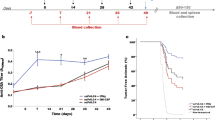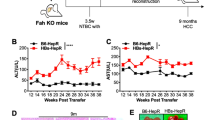Abstract
The oncofetal alpha-fetoprotein (AFP) is reexpressed in the majority of hepatocellular carcinomas and may be used as a target molecule for an immunotherapy or prophylaxis against this tumor. We investigated the potential of DNA vaccination with AFP-expressing plasmid DNA to induce an immune response against AFP-expressing tumor cells in DBA/2 mice. 62.5% of mice vaccinated with AFP-expressing plasmid DNA, rejected subcutaneous syngeneic AFP-expressing P815 tumors, whereas only 16.7% of mice vaccinated with control plasmid rejected these tumor cells (P=.03). Mean survival of mice after challenge with subcutaneous AFP-expressing tumor cells was prolonged for 8 days in mice vaccinated with AFP-expressing DNA (35 days) compared to mice vaccinated with control plasmid (27 days). To rule out possible autoimmune reactions against regenerating liver, which also reexpresses AFP, we evaluated the influence of AFP-specific DNA vaccination on liver regeneration in DBA/2 mice. Histologic quantification of proliferating hepatocytes and of the amount of necrotic liver tissue in carbon tetrachloride–damaged liver did not reveal statistically significant differences in mice vaccinated with AFP-expressing plasmid compared to control mice. These data suggest that AFP-specific DNA vaccination represents a useful tool to inhibit growth of AFP-expressing tumors in mice that does not affect liver regeneration.
This is a preview of subscription content, access via your institution
Access options
Subscribe to this journal
Receive 12 print issues and online access
$259.00 per year
only $21.58 per issue
Buy this article
- Purchase on Springer Link
- Instant access to full article PDF
Prices may be subject to local taxes which are calculated during checkout




Similar content being viewed by others
References
Dürr R, Caselmann WH . Carcinogenesis of primary liver malignancies Langenbecks Arch Surg 2000 385: 154–161
Caselmann WH, Blum HE, Fleig WE et al. Guidelines of the German Society of Digestive and Metabolic Diseases for diagnosis and therapy of hepatocellular carcinoma. German Society of Digestive and Metabolic Diseases Z Gastroenterol 1999 37: 353–365
Bronte V, Apolloni E, Ronca R et al. Genetic vaccination with “self” tyrosinase-related protein 2 causes melanoma eradication but not vitiligo Cancer Res 2000 60: 253–258
Tuting T, Gambotto A, DeLeo A, Lotze MT, Robbins PD, Storkus WJ . Induction of tumor antigen-specific immunity using plasmid DNA immunization in mice Cancer Gene Ther 1999 6: 73–80
Rosato A, Zambon A, Milan G et al. CTL response and protection against P815 tumor challenge in mice immunized with DNA expressing the tumor-specific antigen P815A Hum Gene Ther 1997 8: 1451–1458
Graham RA, Burchell JM, Beverley P, Taylor-Papadimitriou J . Intramuscular immunisation with MUC1 cDNA can protect C57 mice challenged with MUC1-expressing syngeneic mouse tumour cells Int J Cancer 1996 65: 664–670
Conry RM, LoBuglio AF, Loechel F et al. A carcinoembryonic antigen polynucleotide vaccine for human clinical use Cancer Gene Ther 1995 2: 33–38
Morinaga T, Sakai M, Wegmann TG, Tamaoki T . Primary structures of human alpha-fetoprotein and its mRNA Proc Natl Acad Sci USA 1983 80: 4604–4608
Chen H, Egan JO, Chiu JF . Regulation and activities of alpha-fetoprotein Crit Rev Eukaryotic Gene Expression 1997 7: 11–41
Deutsch HF . Chemistry and biology of alpha-fetoprotein Adv Cancer Res 1991 56: 253–312
Ohguchi S, Nakatsukasa H, Higashi T et al. Expression of alpha-fetoprotein and albumin genes in human hepatocellular carcinomas: limitations in the application of the genes for targeting human hepatocellular carcinoma in gene therapy Hepatology 1998 27: 599–607
Wang XW, Xu B . Stimulation of tumor-cell growth by alpha-fetoprotein Int J Cancer 1998 75: 596–599
Fausto N . Liver regeneration J Hepatol 2000 32: 19–31
Ruoslahti E, Pihko H, Vaheri A, Seppala M, Virolainen M, Konttinen A . Alpha fetoprotein: structure and expression in man and inbred mouse strains under normal conditions and liver injury Johns Hopkins Med J, Suppl 1974 3: 249–255
Butterfield LH, Koh A, Meng W et al. Generation of human T-cell responses to an HLA-A2.1–restricted peptide epitope derived from alpha-fetoprotein Cancer Res 1999 59: 3134–3142
Bei R, Budillon A, Reale MG et al. Cryptic epitopes on alpha-fetoprotein induce spontaneous immune responses in hepatocellular carcinoma, liver cirrhosis, and chronic hepatitis patients Cancer Res 1999 59: 5471–5474
Vollmer CM Jr, Eilber FC, Butterfield LH et al. Alpha-fetoprotein–specific genetic immunotherapy for hepatocellular carcinoma Cancer Res 1999 59: 3064–3067
Grimm CF, Ortmann D, Mohr L et al. Mouse alpha-fetoprotein–specific DNA-based immunotherapy of hepatocellular carcinoma leads to tumor regression in mice Gastroenterology 2000 119: 1104–1112
Law SW, Dugaiczyk A . Homology between the primary structure of alpha-fetoprotein, deduced from a complete cDNA sequence, and serum albumin Nature 1981 291: 201–205
Karasuyama H, Melchers F . Establishment of mouse cell lines which constitutively secrete large quantities of interleukin 2, 3, 4 or 5, using modified cDNA expression vectors Eur J Immunol 1988 18: 97–104
Weibel ER . Stereological principles for morphometry in electron microscopic cytology Int Rev Cytol 1969 26: 235–302
Inaba K, Inaba M, Romani N et al. Generation of large numbers of dendritic cells from mouse bone marrow cultures supplemented with granulocyte/macrophage colony-stimulating factor J Exp Med 1992 176: 1693–1702
Lundak RL, Raidt DJ . Cellular immune response against tumor cells: I. In vitro immunization of allogeneic and syngeneic mouse spleen cell suspensions against DBA mastocytoma cells Cell Immunol 1973 9: 60–66
Feltquate DM, Heaney S, Webster RG, Robinson HL . Different T helper cell types and antibody isotypes generated by saline and gene gun DNA immunization J Immunol 1997 158: 2278–2284
Iwasaki A, Stiernholm BJ, Chan AK, Berinstein NL, Barber BH . Enhanced CTL responses mediated by plasmid DNA immunogens encoding costimulatory molecules and cytokines J Immunol 1997 158: 4591–4601
Olsson M, Lindahl G, Ruoslahti E . Genetic control of alpha-fetoprotein synthesis in the mouse J Exp Med 1977 145: 819–827
Wagner H . Bacterial CpG DNA activates immune cells to signal infectious danger Adv Immunol 1999 73: 329–368
Davis HL, Whalen RG, Demeneix BA . Direct gene transfer into skeletal muscle in vivo: factors affecting efficiency of transfer and stability of expression Hum Gene Ther 1993 4: 151–159
Overwijk WW, Lee DS, Surman DR et al. Vaccination with a recombinant vaccinia virus encoding a “self” antigen induces autoimmune vitiligo and tumor cell destruction in mice: requirement for CD4(+) T lymphocytes Proc Natl Acad Sci USA 1999 96: 2982–2987
Nishimura T, Iwakabe K, Sekimoto M et al. Distinct role of antigen-specific T helper type 1 (Th1) and Th2 cells in tumor eradication in vivo J Exp Med 1999 190: 617–627
Cella M, Sallusto F, Lanzavecchia A . Origin, maturation and antigen presenting function of dendritic cells Curr Opin Immunol 1997 9: 10–16
Rock KL, Goldberg AL . Degradation of cell proteins and the generation of MHC class I–presented peptides Annu Rev Immunol 1999 17: 739–779
Condon C, Watkins SC, Celluzzi CM, Thompson K, Falo LD Jr . DNA-based immunization by in vivo transfection of dendritic cells Nat Med 1996 2: 1122–1128
Morgan DJ, Kreuwel HT, Fleck S, Levitsky HI, Pardoll DM, Sherman LA . Activation of low avidity CTL specific for a self epitope results in tumor rejection but not autoimmunity J Immunol 1998 160: 643–651
Limmer A, Sacher T, Alferink J et al. Failure to induce organ-specific autoimmunity by breaking of tolerance: importance of the microenvironment Eur J Immunol 1998 28: 2395–2406
Weber LW, Bowne WB, Wolchok JD et al. Tumor immunity and autoimmunity induced by immunization with homologous DNA J Clin Invest 1998 102: 1258–1264
Tuczek HV, Fritz P, Wagner T, Braun U, Grau A, Wegner G . Synthesis of alpha-fetoprotein (AFP) and cell proliferation in regenerating livers of NMRI mice after partial hepatectomy. An immunohistochemical and autoradiographic study with 3H-thymidine Virchows Arch B: Cell Pathol Incl Mol Pathol 1981 38: 229–237
Engelhardt NV, Baranov VN, Lazareva MN, Goussev AI . Ultrastructural localisation of alpha-fetoprotein (AFP) in regenerating mouse liver poisoned with CCL4: 1. Reexpression of AFP in differentiated hepatocytes Histochemistry 1984 80: 401–407
Wong VS, Wight DG, Palmer CR, Alexander GJ . Fibrosis and other histological features in chronic hepatitis C virus infection: a statistical model J Clin Pathol 1996 49: 465–469
Shimizu M, Yuh K, Aoyama S et al. Immunohistochemical characterization of inflammatory infiltrates at the site of bile duct injury in primary biliary cirrhosis Liver 1986 6: 1–6
Limmer A, Sacher T, Alferink J, Nichterlein T, Arnold B, Hammerling GJ . A two-step model for the induction of organ-specific autoimmunity Novartis Found Symp 1998 215: 159–167
Geissler M, Mohr L, Weth R et al. Immunotherapy directed against α-fetoprotein results in autoimmune liver disease during liver regeneration in mice Gastroenterology 2001 121: 931–939
Acknowledgements
This work was funded by Grant 01GE9613/8 of the German Research Ministry BMBF and a Bonfor Grant 107/58 of the University of Bonn to WHC. We thank Jörg Reimann and Reinhold Schirmbeck, Institute of Medical Microbiology, Ulm, Germany, for helpful discussion concerning the detection of CTLs and for providing the cytokine-expressing plasmids. We thank Olaf Wilke for technical assistance in mouse experiments.
Author information
Authors and Affiliations
Corresponding author
Rights and permissions
About this article
Cite this article
Hanke, P., Serwe, M., Dombrowski, F. et al. DNA vaccination with AFP-encoding plasmid DNA prevents growth of subcutaneous AFP-expressing tumors and does not interfere with liver regeneration in mice. Cancer Gene Ther 9, 346–355 (2002). https://doi.org/10.1038/sj.cgt.7700445
Received:
Published:
Issue Date:
DOI: https://doi.org/10.1038/sj.cgt.7700445
Keywords
This article is cited by
-
ZBTB20 regulates EGFR expression and hepatocyte proliferation in mouse liver regeneration
Cell Death & Disease (2018)
-
Ultrasound-targeted HSVtk and Timp3 gene delivery for synergistically enhanced antitumor effects in hepatoma
Cancer Gene Therapy (2013)
-
Neural Stem Cell-based Gene Therapy for Brain Tumors
Stem Cell Reviews and Reports (2011)
-
A DNA vaccine against chimeric AFP enhanced by HSP70 suppresses growth of hepatocellular carcinoma
Cancer Immunology, Immunotherapy (2007)
-
An attenuated Salmonella oral DNA vaccine prevents the growth of hepatocellular carcinoma and colon cancer that express α-fetoprotein
Cancer Gene Therapy (2006)



